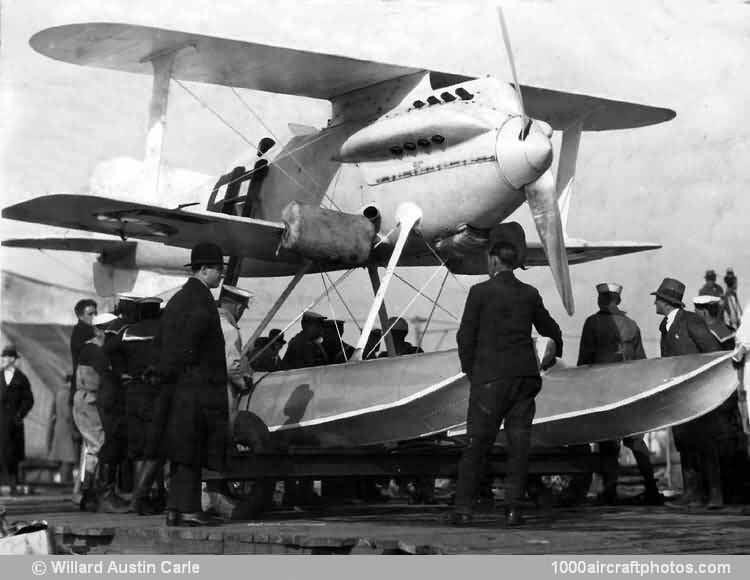04/30/2012. Remarks by Johan Visschedijk: "The USN's victory in the 1923 Schneider Trophy contest at Cowes, England, acted as a great stimulus to both the British and Italian Air Ministries, and when the 1924 contest was postponed for a year, the Gloster and Supermarine companies redoubled their efforts to produce new designs for high-speed floatplanes. In February 1925 the Air Ministry placed orders with these two companies, the one for Gloster covering the design and production of two aircraft.
Like its predecessors, the Gloster III was a single-strut biplane powered by a 700 hp Napier Lion VII twelve-cylinder liquid-cooled broad-arrow engine, which made it the smallest aircraft for its power ever built in Great Britain to that time. Almost inevitably it was a biplane and it needed all of designer Harry P. Folland's ingenuity to produce an aerodynamically clean airframe.
The result was a small frontal-area fuselage of wooden monocoque construction built up from a framework of light ash formers with three-ply skinning. The wire-braced dorsal and ventral fins had wood skinning with fabric covered rudder and elevators. The traditional Folland S.E.5-style fin and rudder was used initially. The three banks of cylinders were carefully cowled with long duralumin 'helmets'. The mainplanes had spruce spars with ash ribs and were fabric covered and the patent Gloster method of attaching fabric to the ribs was retained. Ailerons were fitted only on the lower wings which continued the earlier squared-off tip design while the full-rounded tips were retained on the upper wings.
Folland had designed surface radiators for the Gloster III but unfortunately they were not completed in time to be fitted for flight trials, and so long Lamblin radiators were mounted on the leading edges of the lower mainplanes. Duralumin floats, built by Shorts and weighing some 368 lb (167 kg), were fitted on four streamlined wire-braced struts with two streamlined spreader-bars. These floats were first fitted and tested on the Gloster I before equipping the Gloster III.
At Felixstowe, twelve-day taxiing trials of the first aircraft (s/n N194) began on August 16, 1925, and were completed with some success even though there was very rough water and bad weather throughout the period of the trials. On August 29, Hubert Broad made the first flight of the Gloster III and subsequently reported that, apart from some directional instability, handling characteristics and performance were satisfactory. It was proposed that dihedral should be introduced in the upper mainplanes to match that of the lower ones; however, there was insufficient time for this fundamental modification to be embodied and it was decided only to increase the chord of the dorsal and ventral fins.
With these fin changes the aircraft were designated Gloster IIIAs, and N194 made only four flights with the new tail configuration before it was crated for dispatch to Baltimore. Bert Hinkler flew the second aircraft, registered G-EBLJ, on June 3, 1925, still hampered by poor weather and water conditions, before it was serialed N195 for the contest; but this was his only flight before the aircraft were crated for shipment.
The Gloster contingent of the British team arrived at Bay Shore Park on Chesapeake Bay, near Baltimore, on October 6, 1925, to find weather conditions were even worse than at Felixstowe. No hangars were available for the two Gloster IIIs and the Gloster I (which had been taken over as a spare aircraft) nor accommodation for the crews. Ultimately a leaky canvas hangar was arranged for the Gloster team's use but, largely because of continuing bad weather, the aircraft remained unassembled for several days. On 13 October Hubert Broad managed a 15-min flight in N194 and, when Henri Biard crashed during preliminary flying with the Supermarine S.4, Hinkler's aircraft, N195, was hastily prepared for the contest as a replacement.
Twice HinkIer attempted to complete navigability tests but each time the weather defeated him. Finally, after a 48-hr postponement of the contest date, he set off yet again early in the morning of October 26, but the waves were so strong that they broke two of his float struts and bracing wires. The nose dropped and the propeller chopped into the floats, putting rapid repair beyond possibility. Thus, with hopes of a British victory finally pinned on Broad's Gloster IIIA, the little biplane fought a losing battle with the faster and winning Curtiss R3C-2, and did well to take second place with an average speed of 199.167 mph (320.53 kmh).
After the contest the two Gloster IIIs and the Gloster I were returned to Cheltenham where further modifications were embodied in N195. They included the fitting of the surface radiators on all four mainplanes, a streamlined expansion header tank on the upper center section, a revised and enlarged windscreen, a fully cantilevered tail unit from which all external control levers were removed and with a curved leading edge to the fin, and the use of streamlined bracing wires in place of the earlier round wires used in N194. With these modifications embodied, N195 was redesignated
Gloster IIIB.
N194 was redelivered to Felixstowe in June 1926 and N195 followed it there in November, when both aircraft were used as trainers for the pilots of the RAF High Speed Flight preparing for the 1927 Schneider contest. It is reported that during December 1926 and into April 1927 a number of propellers were flown on development trials on N194, powered with a 700 hp Lion VII engine. They included Fairey Reed and Hele-Shaw Beacham adjustable-pitch propellers of different diameters. The ultimate fate of the two Gloster IIIs cannot be established."
